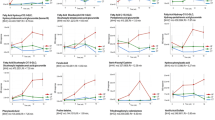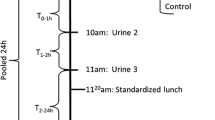Abstract
Purpose
Dietary biomarkers allow the accurate and objective determination of the dietary intake of humans and can thus be valuable for investigating the relation between consumption of foods and biochemical as well as physiological responses. The objective of this study was the identification of potential urinary biomarkers for consumption of tomato juice.
Methods
In the course of a dietary intervention study, the human urine metabolome of a study cohort was compared between a tomato-free diet and after intake of tomato juice by application of an LC-HRMS-based metabolomics approach. The data acquisition was achieved using an orbitrap mass spectrometer, followed by multistage data processing and univariate as well as multivariate statistical analysis to identify discriminating features.
Results
Statistical analysis revealed several unique features detectable after tomato juice intake. The most discriminating markers were putatively identified as hydroxylated and sulfonated metabolites of esculeogenin B, aglycone of the steroidal glycoalkaloid esculeoside B recently found in tomato juice. Furthermore, the β-carboline alkaloids tangutorid E and F and glucuronidated derivatives thereof were identified in urine.
Conclusions
Steroidal glycoalkaloids in tomato juice are cleaved after ingestion, and hydroxylated and sulfonated metabolites of their aglycones might serve as urinary biomarkers for tomato juice intake. Similarly, β-carboline alkaloids and glucuronidated derivatives were identified as potential urinary biomarkers. Both the aglycones of the steroidal alkaloids and the β-carboline alkaloids might exhibit biological activities worth investigating.






Similar content being viewed by others
Abbreviations
- ACN:
-
Acetonitrile
- br:
-
Broad
- FC:
-
Fold change
- HCD:
-
Higher-energy collision induced dissociation
- HESI:
-
Heated electrospray ionization
- HRMS:
-
High-resolution mass spectrometry
- LC:
-
Liquid chromatography
- MeOH:
-
Methanol
- PCA:
-
Principal component analysis
References
Thompson FE, Subar AF, Loria CM, Reedy JL, Baranowski T (2010) Need for technological innovation in dietary assessment. J Acad Nutr Diet 110:48–51
Bingham SA (2002) Biomarkers in nutritional epidemiology. Public Health Nutr 5:821–827
McCabe-Sellers B (2010) Advancing the art and science of dietary assessment through technology. J Am Diet Assoc 110:52–54
Hedrick VE, Dietrich AM, Estabrooks PA, Savla J, Serrano E, Davy BM (2012) Dietary biomarkers: advances, limitations and future directions. Nutr J 11:109
Wishart DS (2008) Metabolomics: application to food science and nutrition research. Trends Food Sci Technol 19:482–493
Heinzmann SS, Brown IJ, Chan Q, Bictash M, Dumas ME, Kochhar S et al (2010) Metabolic profiling strategy for discovery of nutritional biomarkers: proline betaine as a marker of citrus consumption. Am J Clin Nutr 92:436–443
Lloyd AJ, Beckmann M, Fave G, Mathers JC, Draper J (2011) Proline betaine and its biotransformation products in fasting urine samples are potential biomarkers of habitual citrus fruit consumption. Br J Nutr 106:812–824
Lang R, Lang T, Bader M, Beusch A, Schlagbauer V, Hofmann T (2017) High-throughput quantitation of proline betaine in foods and suitability as a valid biomarker for citrus consumption. J Agric Food Chem 65:1613–1619
Mennen LI, Sapinho D, Ito H, Bertrais S, Galan P, Hercberg S et al (2006) Urinary flavonoids and phenolic acids as biomarkers of intake for polyphenol-rich foods. Br J Nutr 96:191–198
Saenger T, Hübner F, Humpf HU (2017) Short-term biomarkers of apple consumption. Mol Nutr Food Res 61:1600629
Ito H, Gonthier MP, Manach C, Morand C, Mennen L, Rémésy C et al (2005) Polyphenol levels in human urine after intake of six different polyphenol-rich beverages. Br J Nutr 94:500–509
Llorach R, Urpi-Sarda M, Jauregui O, Monagas M, Andres-Lacueva C (2009) An LC-MS-based metabolomics approach for exploring urinary metabolome modifications after cocoa consumption. J Proteom Res 8:5060–5068
Canene-Adams K, Campbell JK, Zaripheh S, Jeffery EH, Erdman JW (2005) The tomato as a functional food. J Nutr 135:1226–1230
Ghavipour M, Saedisomeolia A, Djalali M, Sotuodeh G, Eshraghyan MR, Moghadam AM et al (2013) Tomato juice consumption reduces systemic inflammation in overweight and obese females. Br J Nutr 109:2031–2035
Ghavipour M, Sotoudeh G, Ghorbani M (2015) Tomato juice consumption improves blood antioxidative biomarkers in overweight and obese females. Clin Nutr 34:805–809
Silaste ML, Alfthan G, Aro A, Kesäniemi YA, Hörkkö S (2007) Tomato juice decreases LDL cholesterol levels and increases LDL resistance to oxidation. Br J Nutr 98:1251–1258
Moco S, Bino RJ, Vorst O, Verhoeven HA, de Groot J, van Beek TA et al (2006) A liquid chromatography-mass spectrometry-based metabolome database for tomato. Plant Physiol 141:1205–1218
Iijima Y, Watanabe B, Sasaki R, Takenaka M, Ono H, Sakurai N et al (2013) Steroidal glycoalkaloid profiling and structures of glycoalkaloids in wild tomato fruit. Phytochem 95:145–157
Nohara T, Fujiwara Y, Zhou JR, Urata J, Ikeda T, Murakami K et al (2015) Saponins, esculeosides B-1 and B-2, in tomato juice and sapogenol, esculeogenin B1. Chem Pharm Bull 63:848–850
Cichon MJ, Riedl KM, Wan L, Thomas-Ahner JM, Francis DM, Clinton SK et al (2017) Plasma metabolomics reveals steroidal alkaloids as novel biomarkers of tomato intake in mice. Mol Nutr Food Res 61:1700241
Gika HG, Theodoridis GA, Plumb RS, Wilson ID (2014) Current practice of liquid chromatography-mass spectrometry in metabolomics and metabonomics. J Pharm Biomed Anal 87:12–25
Werner E, Heilier JF, Ducruix C, Ezan E, Junot C, Tabet JC (2008) Mass spectrometry for the identification of the discriminating signals from metabolomics: current status and future trends. J Chromatogr 871:143–163
Chambers MC, MacLean B, Burke R, Amode D, Ruderman DL, Neumann S et al (2012) A cross-platform toolkit for mass spectrometry and proteomics. Nat Biotechnol 30:918–920
Pluskal T, Castillo S, Villar-Briones A, Oresic M (2010) MZmine 2: modular framework for processing, visualizing, and analyzing mass spectrometry-based molecular profile data. BMC Bioinform 11:395
Xia J, Wishart DS (2016) Using MetaboAnalyst 3.0 for comprehensive metabolomics data analysis. Curr Protoc Bioinform 55:14.10.1–14.10.91
Wishart DS, Feunang YD, Marcu A, Guo AC, Liang K, Vazquez-Fresno R et al (2018) HMDB 4.0: the human metabolome database for 2018. Nucleic Acids Res 46:D608–D617
Smith CA, O’Maille G, Want EJ, Qin C, Trauger SA, Brandon TR et al (2005) METLIN: a metabolite mass spectral database. Ther Drug Monit 27:747–751
Sumner LW, Amberg A, Barrett D, Beale MH, Beger R, Daykin CA et al (2007) Proposed minimum reporting standards for chemical analysis. Metabolomics 3:211–221
Diem S, Herderich M (2001) Reaction of tryptophan with carbohydrates: identification and quantitative determination of novel β-carboline alkaloids in food. J Agric Food Chem 49:2486–2492
Zhao JQ, Wang YM, Yang YL, Zeng Y, Wang QL, Shao Y et al (2017) Isolation and identification of antioxidant and α-glucosidase inhibitory compounds from fruit juice of Nitraria tangutorum. Food Chem 227:93–101
Caprioli G, Cahill M, Logrippo S, James K (2015) Elucidation of the mass fragmentation pathways of tomatidine and β1-hydroxytomatine using orbitrap-mass spectrometry. Nat Prod Commun 10:575–576
Levsen K, Schiebel HM, Behnke B, Dötzer R, Dreher W, Elend M (2005) Structure elucidation of phase II metabolites by tandem mass spectrometry: an overview. J Chromatogr A 1067:55–72
Strott CA (2002) Sulfonation and molecular action. Endocr Rev 23:703–732
Leowattana W (2004) DHEAS as a new diagnostic tool. Clin Chim Acta 341:1–15
Fujiwara Y, Takaki A, Uehara Y, Ikeda T, Okawa M, Yamauchi K et al (2004) Tomato steroidal alkaloid glycosides, esculeosides A and B, from ripe fruits. Tetrahedron 60:4915–4920
Manabe H, Fujiwara Y, Ikeda T, Ono M, Murakami K, Zhou JR et al (2013) Saponins esculeosides B-1 and B-2 in Italian canned tomatoes. Chem Pharm Bull 61:764–767
Friedman M (2002) Tomato glycoalkaloids: role in the plant and in the diet. J Agric Food Chem 50:5751–5780
Nohara T, Ono M, Ikeda T, Fujiwara Y, El-Aasr M (2010) The tomato saponin, esculeoside A. J Nat Prod 73:1734–1741
Fujiwara Y, Kiyota N, Hori M, Matsushita S, Iijima Y, Aoki K et al. Arterioscler (2007) Esculeogenin A, a new tomato sapogenol, ameliorates hyperlipidemia and atherosclerosis in ApoE-deficient mice by inhibiting ACAT. Thromb Vasc Biol 27:2400–2406
Fujiwara Y, Kiyota N, Tsurushima K, Yoshitomi M, Horlad H, Ikeda T et al (2012) Tomatidine, a tomato sapogenol, ameliorates hyperlipidemia and atherosclerosis in ApoE-deficient mice by inhibiting Acyl-CoA:cholesterol Acyl-transferase (ACAT). J Agric Food Chem 60:2472–2479
Allen JRF, Holmstedt BR (1980) The simple β-carboline alkaloids. Phytochem 19:1573–1582
Adachi J, Mizoi Y, Naito T, Ogawa Y, Uetani Y, Ninomiya I (1991) Identification of tetrahydro-β-carboline-3-carboxylic acid in foodstuffs, human urine and human milk. J Nutr 121:646–652
Herraiz T, Galisteo J (2002) Identification and occurrence of the novel alkaloid pentahydroxypentyl-tetrahydro-β-carboline-3-carboxylic acid as a tryptophan glycoconjugate in fruit juices and jams. J Agric Food Chem 50:4690–4695
Cao R, Peng W, Wang Z, Xu A (2007) β-Carboline alkaloids: biochemical and pharmacological functions. Curr Med Chem 14:479–500
Khan H, Patel S, Kamal MA (2017) Pharmacological and toxicological profile of harmane-β-carboline alkaloid: friend or foe. Curr Drug Metab 18:853–857
Acknowledgements
The authors express their gratitude to Andrea Jansen and Steffen Lürwer for assistance in the course of isolation of the compounds.
Author information
Authors and Affiliations
Contributions
YH, FH, and HUH were involved in the design of the human study. YH and FH were further responsible for the conduct of the latter. The metabolomics analysis was carried out by FH, RS, and YH, whereas AJ and YH were involved in the isolation of the described compounds. HUH was responsible for the study supervision. All authors contributed to the preparation of the manuscript and gave their approval to the final version.
Corresponding author
Ethics declarations
Conflict of interest
The authors have declared no conflict of interest.
Electronic supplementary material
Below is the link to the electronic supplementary material.
Rights and permissions
About this article
Cite this article
Hövelmann, Y., Jagels, A., Schmid, R. et al. Identification of potential human urinary biomarkers for tomato juice intake by mass spectrometry-based metabolomics. Eur J Nutr 59, 685–697 (2020). https://doi.org/10.1007/s00394-019-01935-4
Received:
Accepted:
Published:
Issue Date:
DOI: https://doi.org/10.1007/s00394-019-01935-4




